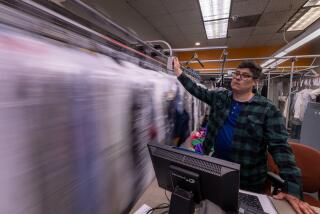Must Reads: The art gallery exodus from Boyle Heights and why more anti-gentrification battles loom on the horizon
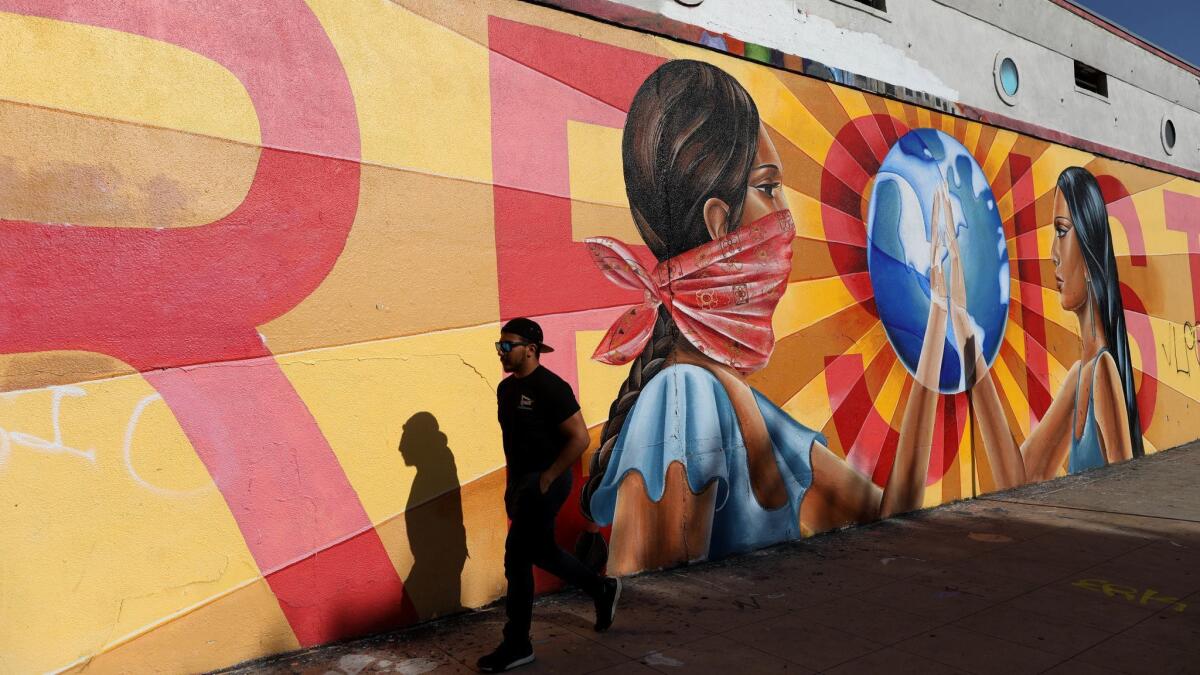
- Share via
On a warm evening in early May, gallerist Robert Zin Stark turned up for a meeting with anti-gentrification activists from the Boyle Heights Alliance Against Artwashing and Displacement (B.H.A.A.A.D.) at a tidy, century-old bungalow just west of the 101 Freeway — the offices of the neighborhood advocacy group Unión de Vecinos.
Waiting for him when he arrived was a scene worthy of insurgent agitprop: A handful of casually clad activists seated at a long table were backed by a dozen individuals in black jumpsuits and red ski masks standing shoulder to shoulder.
For the record:
5:30 p.m. Aug. 8, 2018An earlier version of this story reported that MaRS gallery opened in 2015. It opened in September of 2014.
“There was a table with four women from the community,” recalls Stark. “And there was one folding chair on the other side for me.”
On the agenda, says Stark, the founder and director of the MaRS gallery (short for Museum as Retail Space), was a discussion about “the realities of economic violence” and the need for “people involved in the gallery system to consider where their own power comes from.”
The whole experience, he recalls, “was a little bit like ‘Clockwork Orange’ meets ‘Eyes Wide Shut.’”
The ultimate purpose of the meeting was to discuss the future of his gallery — or, to be more exact, its nonfuture.
For more than two years, members of B.H.A.A.A.D., a coalition of anti-gentrification groups in Boyle Heights, have repeatedly demanded that galleries leave the neighborhood; what the neighborhood needs, the groups insist, is more affordable housing, as well as residential services such as grocery stores and laundromats. Publicly vowing to “stop at nothing to fight gentrification and capitalism in its boring art-washing manifestations, the group has staged protests, called for boycotts and used social media in savvy and withering ways — for example, describing one gallery owner as bearing the “stench of entitlement and white privilege.”
There have been other more questionable tactics too. A couple of galleries have reported anonymous death threats and other harassment. In 2016, an anonymous vandal spray-painted an epithet about “white art” on the gates of Nicodim Gallery. Last month, a statement appeared on the website of BBQLA, a space just off Whittier Boulevard, apologizing for its role “as hipster bro gentrifiers who have colonized Boyle Heights with our gallery.” The gallery’s directors stated via email that their website had been hacked, and they declined to comment further so as not to “perpetuate negativity.”
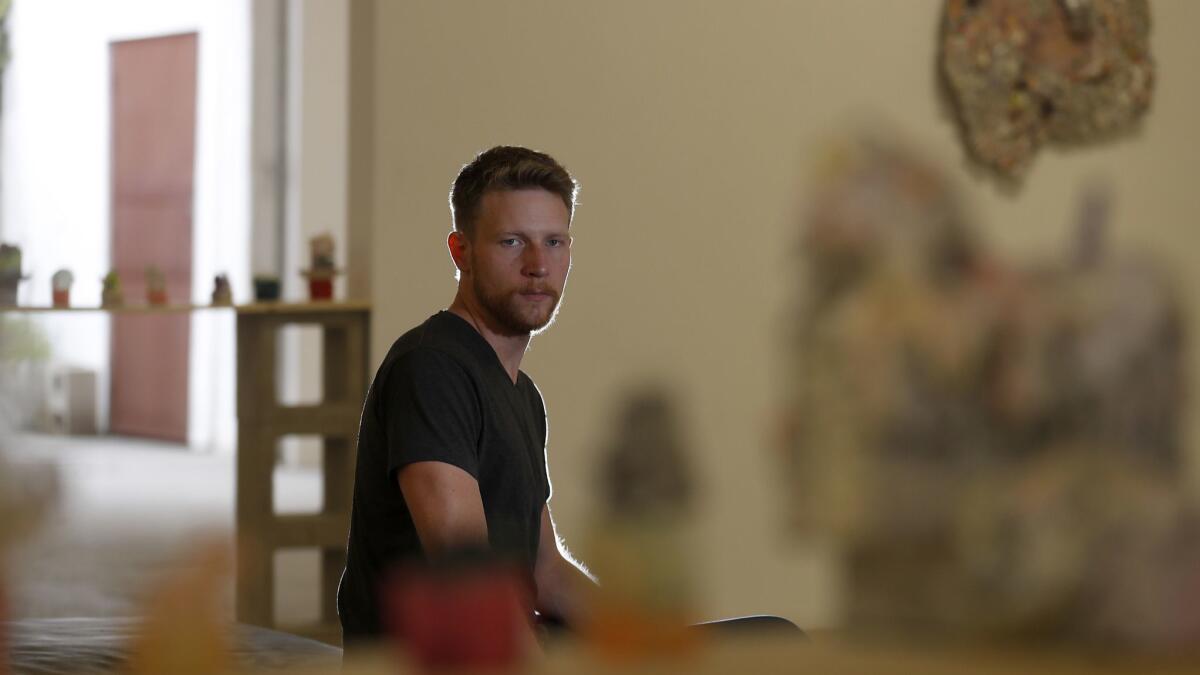
Stark took the protests to heart — later this month, he plans to hold a “ceremonial closing” of his space.
“I want to lend my social capital and my voice to bringing another dialogue,” he said.
He is not alone in his decision to leave the area. In recent months, several art spaces have abandoned the informal gallery zone that had materialized over the last five years in the area known as the Flats, the low-lying, largely industrial sliver of Boyle Heights that borders the Los Angeles River.
Venus Los Angeles, run by billionaire art collector Adam Lindemann, closed without notice in January. In March, 356 Mission, an artist-run space operated by painter Laura Owens and book dealer Wendy Yao, announced that it too would be closing down. The following month, UTA Artist Space, the visual arts outpost of the Hollywood talent agency, posted a notice on its website that the gallery was “Closed for Relocation.” Last month, the space reopened in Beverly Hills.
And right around the time that Stark was sitting down for his meeting with B.H.A.A.A.D., Eva Chimento, founder of Chimento Contemporary, also announced that she was leaving Boyle Heights.
“All my clients are on the Westside,” she told The Times in the wake of her announcement. “And I was doing too many art fairs to compensate. The downtown area is difficult.”
Chimento says she isn’t leaving because of the protests, but added that they “made the decision easier.” She has since relocated to West Adams.
Whatever the stated reason for the departures, the declining number of art spaces in Boyle Heights — from more than a dozen to half that — has been greeted with satisfaction by activists.
“Our signature flurry of disciplined, militant tactics are working,” reads a blog post on the website of Defend Boyle Heights, a group that is part of the B.H.A.A.A.D. coalition.
(The movement contains some prominent members, such as activist Nancy Meza, but as a general rule, members operate anonymously, choosing to issue statements under a collective banner.)
Yet even as the closures might seem to mark a turning point for the neighborhood’s anti-gentrification battles, larger development issues loom on the horizon — issues that will not be resolved even if every gallery in Boyle Heights were to immediately pack up and leave, and issues that, for now, B.H.A.A.A.D has largely not addressed.
The Department of City Planning is in the middle of rewriting zoning code for the neighborhood, developing a draft community plan that will set boundaries for development in the area. This includes proposals for higher-density building around public transit and the designation of an innovation district for the industrial portions of the Flats (where MaRS and other galleries are located).
In addition, last year’s federal tax law required states to create economic opportunity zones in poor neighborhoods that contain some industrial or commercial infrastructure. The law seeks to spur development in areas that have not benefited from the economic recovery, but it does not require investors to support the public good with their projects (such as providing economic benefit to those who live in the zone). One of these zones lies in the northern section of the Flats, from 4th Street to the 101 Freeway.
There is also the pending redevelopment of the old Sears, Roebuck & Co. mail order building by the Shomof Group. The 13-acre Art Deco structure, completed in 1927 and located at the intersection of East Olympic Boulevard and South Boyle Avenue, is set to be remade as a mixed-use complex that includes industrial-chic lofts, 200,000 square feet of creative offices and amenities such as a putting green and a pool. The website for the project has re-baptized the site the Mail Order District in honor of the building’s history as a catalog fulfillment center.
According to plans filed with the Department of City Planning, some of the development’s 1,030 dwellings will be set aside for artist and designers. Not one has been designated as affordable or low income. This, in a neighborhood where, according to census data, the median household income is $33,235 (versus $57,952 for the county).
“There are,” says Isela Gracian, an affordable-housing advocate in Boyle Heights, “a lot of challenges.”
“It’s all market-rate development,” adds Gracian, president of the East L.A. Community Corp. (ELACC), a nonprofit advocacy group and housing developer based in Boyle Heights. “It’s going through without any affordable housing.”
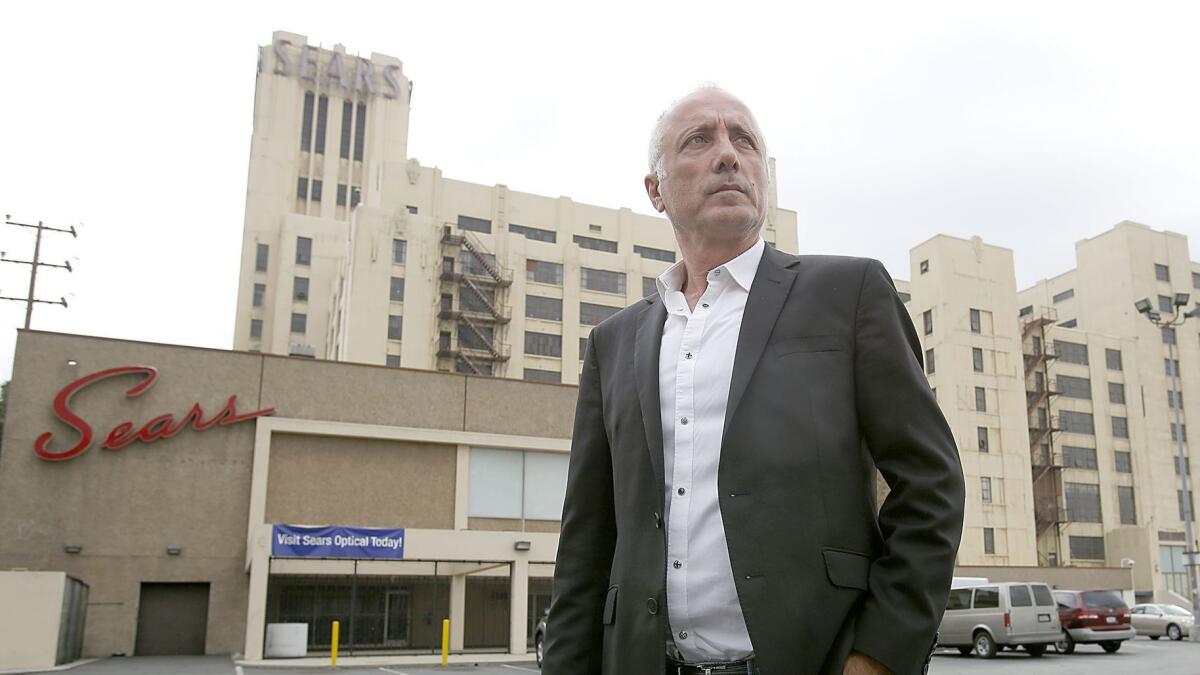
The Sears project, in particular, has the potential to remake the southern swath of the neighborhood.
Part of this is due to the nature of converting previously uninhabited commercial or industrial land to residential use. In a residential zone, developers have to take into account the right of return of tenants. But in an industrial zone, says Gracian, “people say, ‘Residents don’t live there, so we don’t have to do that.’”
This can result in skyrocketing real-estate prices — a phenomenon that has occurred in the Arts District across the river in downtown Los Angeles, where large tracts of commercial land have been turned over to residential use.
“Once you start allowing housing, it’s difficult from a legal standpoint, it’s difficult to mandate what type of housing it should be,” says Craig Weber, principal city planner for the city of Los Angeles. “A zoning plan can require some gymnastics that require some affordable housing, but it will still bring market rate units, which bring unintended consequences.”
Such as squeezing out the light industrial businesses that are an important source of blue collar jobs. “As the environment changes to be more residential,” Weber adds, “those lingering produce distribution and beverage distribution centers, they get pushed out, because stakeholders start to say, ‘What’s with all this truck traffic?’”
Pressure from the community and local elected officials (the neighborhood sits in the Eastside district represented by City Councilman Jose Huizar) might have shifted the scope of the project, which is currently in the planning stages — perhaps resulting in the inclusion of low-income or affordable units. But there has been limited input from the community, and unlike the emergence of the gallery district, the Sears project has drawn little attention from protestors.
“We submitted a letter and talked to the developer, encouraging affordable housing,” says Gracian. “But there wasn’t enough organized opposition.”
Protestors have also been absent from the zoning process.
“City Planning’s outreach events over the past several years have been well attended and productive,” says Weber. “We have made great efforts to coordinate our outreach with the Boyle Heights Neighborhood Council, as well as other local stakeholder groups.”
Defend Boyle Heights and the Unión de Vecinos did not respond to requests for comment on this story. Contacted through Facebook, a representative for B.H.A.A.A.D. stated that “art galleries fabricate their own truth about Boyle Heights” and that “art writers are complicit in gentrification by prioritizing the voices of gentrifying institutions and artists over community.”
The focus on galleries has been a tactical decision, says Rigo Amavizca, an activist with the Comité de la Esperanza, a tenant rights organization for the Wyvernwood Garden Apartments, a historic rent-stabilized complex on Olympic Boulevard, who for a time was involved with Defend Boyle Heights.
“We have to put our focus where we think we can win,” he says. “We are limited in personnel and in what we can do.”
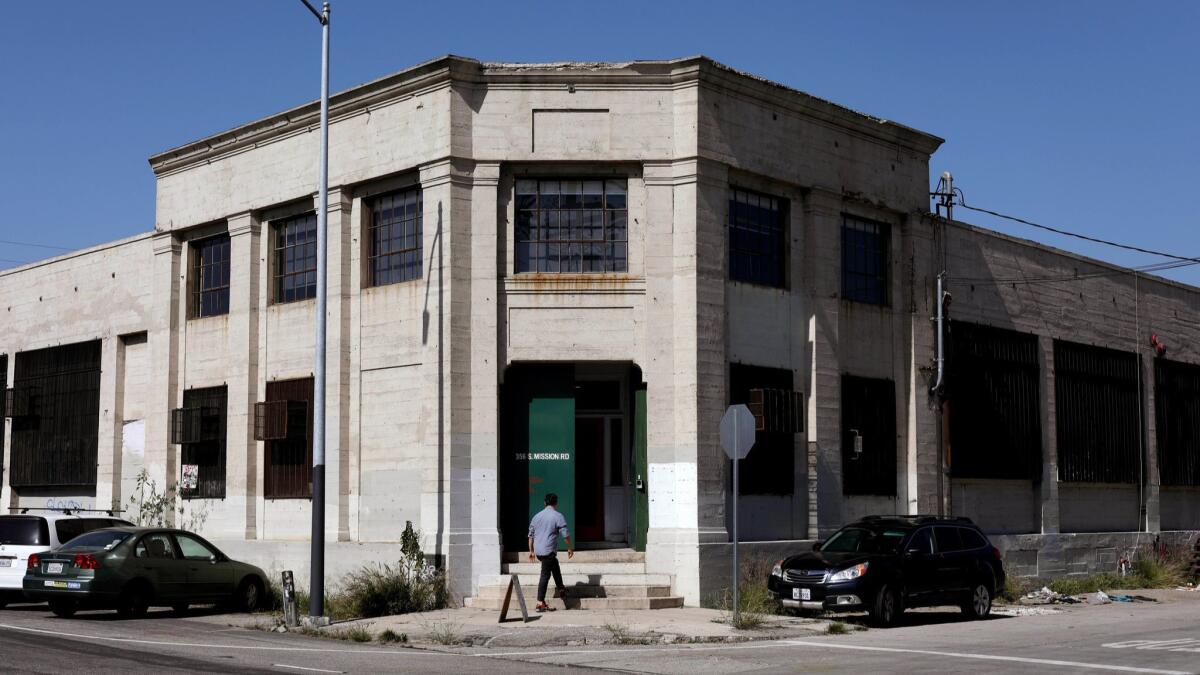
The protests against galleries have kept the issue of gentrification top of mind, generating media coverage that a demonstration on the steps of City Hall simply could not. (Plug the words “Boyle Heights” into Google and “gentrification” immediately pops up as a suggested term.)
“Before Defend Boyle Heights came on the map, the conversation about gentrification and displacement was taking place in the neighborhood,” says Gracian, who notes that community groups such as Legacy L.A. and InnerCity Struggle have long been working on the issue. But the protests have given “some oomph” to the work.
And as Los Angeles continues to be gripped by a housing crisis, the protests are not only not going away but they are also evolving — even if for now they remain more focused on protesting specific businesses than in hammering out policy.
Last month, for example, activists staged a protest outside Asher Caffé, a new coffee shop on Boyle Avenue that is operated by a supporter of Donald Trump.
The fight has also spilled out of Boyle Heights. In April, unidentified individuals splashed red paint inside Dalton Warehouse, an artist studio complex in Historic South-Central. And Defend Boyle Heights has led workshops on anti-gentrification protest tactics with groups from Chicago and the Bronx.
Stark opened MaRS in Boyle Heights in an old warehouse on South Anderson Street in 2014. A year later, the protests began.
Initially, he says, he dismissed them as misdirected.
“I was like, ‘I’m a small business. I’m doing this as an ambitious entrepreneur,” he says.
But as the protests wore on and his collector base grew skittish about buying work from a gallery in Boyle Heights, he says he began to have sympathy for the protestors’ fierce devotion to their cause.
“It’s made me question the gallery system itself,” he says.
Whatever you think of their focus or tactics, Stark says it’d be a mistake to dismiss the protests’ underlying message.
“I’ve been the person in the palace kind of making light of the people in the palace,” he says. “But now I’m pointing out the window and I’m like, ‘There’s angry people outside and there’s a lot of them and maybe we should take that seriously.’”

ALSO
Boyle Heights activists protest art galleries, gentrification
As rents soar in L.A., even Boyle Heights’ mariachis sing the blues
As gentrification closes in, immigrants in Lincoln Heights find their American dream slipping away
Vandal targets coffee shop at center of anti-gentrification protests in Boyle Heights
Sign up for our weekly Essential Arts & Culture newsletter »
More to Read
The biggest entertainment stories
Get our big stories about Hollywood, film, television, music, arts, culture and more right in your inbox as soon as they publish.
You may occasionally receive promotional content from the Los Angeles Times.


